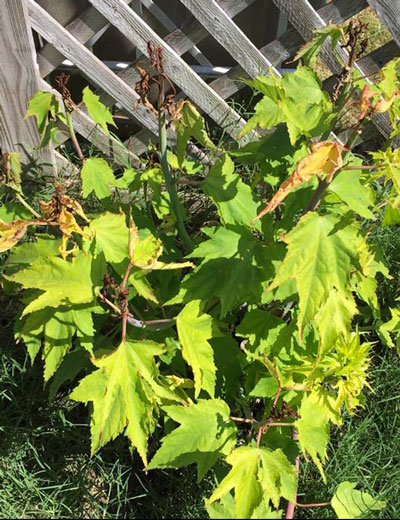Question of the Week Number 2: June 14, 2018
“What is happening to my hardy hibiscus? I’m afraid it’s dying. What can I do to save it?”
I get this sort of question many times every year from late spring into the fall. It pertains to all kinds of plants, from shrubs to shade trees, so I didn’t think a lot about it when it came into my Facebook page recently relative to hardy hibiscus, the perennial mallow.

Hardy hibiscus (mallows) as photographed by Angie C. in McKinney a few days ago.
My first thought as I saw this photo was that it was the beginning of cotton root rot. That’s a soil-borne fungus that kills plants quickly, often within just a few days or weeks, almost as if they’d been cut off at the ground, then reinserted back into the soil without roots.
Cotton root rot is the main reason you don’t see cotton being grown along I-35 any longer. It became so common that farmers couldn’t justify planting the crop when they knew they would lose half or more of their plantings. There is no reliable cure or control other than to plant crops that are not susceptible. But more on that some other time. This story is about something else.
BUT WAIT!
The leaves on these hardy hibiscus plants don’t look quite right. And the plant isn’t dying all at one time like cotton root rot would do. The tips have died back while the rest of the plant is still trying to survive.
That’s when I asked about weed-and-feed products or any kind of weedkiller that might have been applied, and the lady said that the lawn care company had been there a few days ahead of this problem breaking out. Another plant or two had been hurt as well. Let’s hear a big “Aha!”
Our takeaway…
Here’s what I see that might be of help to you in identifying weedkiller injury, specifically broadleafed weedkiller types:
• Malformed leaves, especially at the growing tips. The leaves may look unusually pointed or stretched, almost as if they were made of plastic and had gotten too hot.
• Tip growth may be cupped or browned.
• This can happen when weed-and-feed products are applied around broadleafed plants (non-grasses). It can also happen when sprays are allowed to drift onto vulnerable plants.
• Hopefully symptoms will begin to improve within a few days or weeks and affected plants will be able to recover.
• Do not fertilize injured plants, but keep them watered properly.
• Keep records and photos of what you see and when you see it. Better yet, ask lawn care companies what they will be using before they make their applications to make sure everything is needed and applied correctly.
